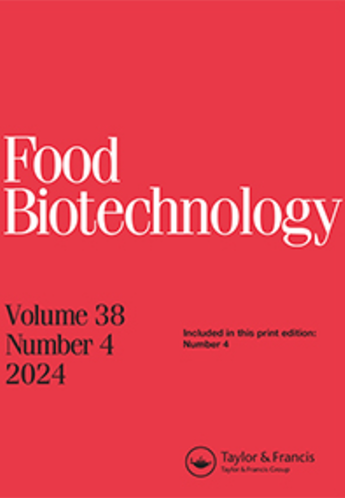利用热酶PC10F制备罗非鱼(Oreochromis sp.)皮肤I型胶原水解产物及其硅分析
IF 1.6
4区 农林科学
Q4 BIOTECHNOLOGY & APPLIED MICROBIOLOGY
引用次数: 3
摘要
摘要本研究旨在利用热酶PC10F与罗非鱼皮的新型组合作为蛋白胶原源,从I型胶原中制备血管紧张素- 1转换酶(ACE)抑制肽。分别使用Protparam和BIOPEP对I型胶原的氨基酸谱、ace抑制肽和水解产物的感觉谱进行了计算机评价,以初步预测产生的潜在肽。以邻苯二醛(OPA)法水解度(DH)的最佳初步设计为基础,研究了水解条件。温度为60℃,pH为5,酶底比为1:100是使用Thermoase PC10F获得最高DH的最佳条件。肽链长度(PCL)随DH的增加呈比例减小。对α 1和α 2型胶原蛋白的硅片研究表明,α 1和α 2型胶原蛋白中含有大量的甘氨酸和脯氨酸,这两种物质可以稳定胶原蛋白的结构。结果表明,从ⅰ型胶原α 1和α 2亲本蛋白序列中可获得247个ace抑制肽。在硅中,热溶素水解被认为可以释放出IC50小于5 μM的理论肽,这两种I型胶原亚基都有很高的发生率。对其潜在感觉肽的进一步分析表明,α 1和α 2主要含有甜氨基酸、苦肽和苦味氨基酸。本文章由计算机程序翻译,如有差异,请以英文原文为准。
The production of collagen type I hydrolyzate derived from tilapia (Oreochromis sp.) skin using thermoase PC10F and its in silico analysis
ABSTRACT The main focus of this study was to produce the angiotensin-I converting enzyme (ACE) inhibitory peptides from collagen type I using new combination of Thermoase PC10F and tilapia skin as a protein collagen source. In silico evaluation of amino acids profile of collagen type I, ACE-inhibitory peptides and sensory profile of the hydrolyzate were performed using Protparam and BIOPEP, respectively, to initially predict the potential peptide produced. Hydrolysis conditions were studied based on the best preliminary design of degree hydrolysis (DH) using o-phthalaldehyde (OPA) method. The temperature of 60°C, pH of 5 and an enzyme to substrate ratio of 1:100 were observed as the best conditions to obtain the highest DH using Thermoase PC10F. Peptide chain length (PCL) showed a proportional decrease as DH increased. In silico study of alpha 1 and alpha 2 collagen type I indicated a significant amount of glycine and proline, which are known to stabilize the collagen structure. The profile of potential biological activity suggested that 247 ACE-inhibitory peptides could be obtained from the parent protein sequence of collagen type I alpha 1 and alpha 2. In silico hydrolysis by thermolysin is believed to release potent theoretical peptides with IC50 less than 5 μM for both collagen type I subunits with a high number of occurrences. Further analysis on its potential sensory peptides had shown that both alpha 1 and alpha 2 contained mainly sweet amino acid, bitter peptides, and bitter amino acids.
求助全文
通过发布文献求助,成功后即可免费获取论文全文。
去求助
来源期刊

Food Biotechnology
工程技术-生物工程与应用微生物
CiteScore
3.80
自引率
0.00%
发文量
15
审稿时长
>12 weeks
期刊介绍:
Food Biotechnology is an international, peer-reviewed journal that is focused on current and emerging developments and applications of modern genetics, enzymatic, metabolic and systems-based biochemical processes in food and food-related biological systems. The goal is to help produce and improve foods, food ingredients, and functional foods at the processing stage and beyond agricultural production.
Other areas of strong interest are microbial and fermentation-based metabolic processing to improve foods, food microbiomes for health, metabolic basis for food ingredients with health benefits, molecular and metabolic approaches to functional foods, and biochemical processes for food waste remediation. In addition, articles addressing the topics of modern molecular, metabolic and biochemical approaches to improving food safety and quality are also published.
Researchers in agriculture, food science and nutrition, including food and biotechnology consultants around the world will benefit from the research published in Food Biotechnology. The published research and reviews can be utilized to further educational and research programs and may also be applied to food quality and value added processing challenges, which are continuously evolving and expanding based upon the peer reviewed research conducted and published in the journal.
 求助内容:
求助内容: 应助结果提醒方式:
应助结果提醒方式:


